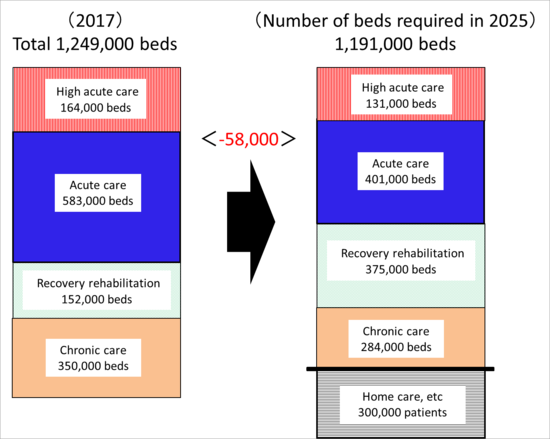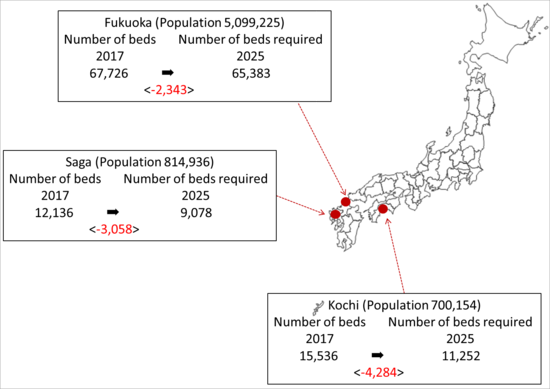Column Finance and the Social Security System 2019.06.17
【Aging, safety net and fiscal crisis in Japan】No.199: Is the Community Healthcare Reform Plan going to remain a Pipe Dream?
The government is currently promoting a healthcare reform, with the aim of implementing it by 2025. One of the pillars of this reform is the reduction in the number of hospital beds, as well as changes in their designated functions. The number of beds, excluding those for psychiatric and infectious diseases, was 1,249,000 in 2017. This reform plans to reduce this by 58,000 to 1,191,000 (Figure 1). In addition, while the number of hospital beds for high-acute, acute, and chronic stage illnesses are largely reduced in the proposal, it is stated that the number designated for recovery and rehabilitation will become 375,000, more than doubled from 152,000 in 2017. On the other hand, the number of home care patients (108,100 in 2017, as stated in Column No. 175) is planned to increase to 300,000 in response to the proposed hospital bed reduction.
Prefectures are responsible for this reform. Therefore, the proportion of bed reduction is larger for those prefectures where the current amount of beds is greater than the actual number required in order to match the demand, and inpatient care is over-assumed. For example, as shown in Figure 2, the Kochi Prefecture has to reduce its hospital bed numbers by 27.6% from 15,536 in 2017 to a target of 11,252 by 2025. The Saga Prefecture also has to reduce its bed count, this time by 25.2% from 12,136 in 2017 to 9,078, by 2025. In the case of Fukuoka Prefecture, which is well known for its excessive consumption of healthcare (see Column No. 10), the number of beds required to be removed from the total of 67,726 in 2017 is relatively small at only 2,343.
However, as shown in Table 1, it will be required for all prefectures to increase the number of beds designated for recovery and rehabilitation by 11,147, while reducing those marked for high-acute, acute, and chronic care by 13,490. As the alterations in the number of beds, as well as their functional changes, have a large influence on the financial balance of hospitals, it tends to generate conflict among hospitals in the same region. Prefectures' final decisions on this reform plan are not legally enforceable. Therefore, there is a concern that the community healthcare reform plan is likely to end up as simply a pipe dream.



